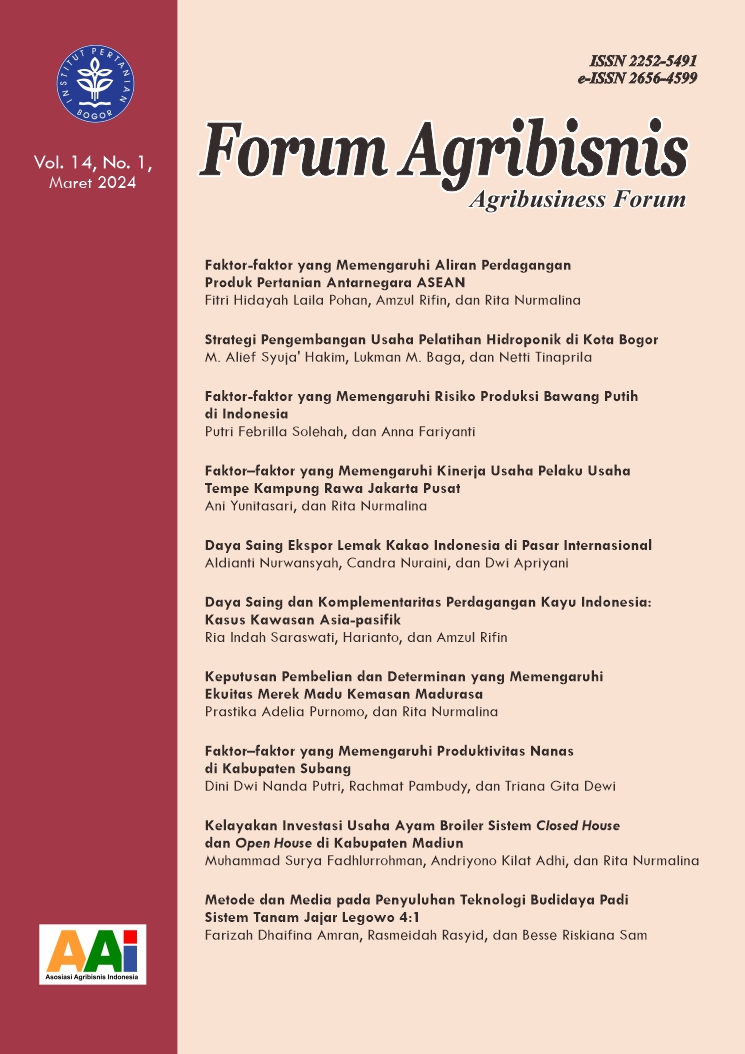Faktor-Faktor Yang Memengaruhi Aliran Perdagangan Produk Pertanian Antar Negara ASEAN
Main Article Content
Abstract
The agricultural sector has an important role for national economic development, especially countries in the ASEAN region with a climate that is very suitable for agricultural activities. Trade in agricultural products between ASEAN countries in terms of exports has gradually increased, but exports out of the region are very large. The lower export ratio in the ASEAN region can be due to ASEAN's highly competitive agricultural products, but this cannot increase the import ratio between countries. This condition explains that the utilization of opportunities in trade activities in the ASEAN region has not been optimal. The purpose of the study is to determine the factors that influence the flow of trade in agricultural products between ASEAN countries. The data used by researchers are secondary data in the agricultural sector for the period 2013 to 2022 with variables of GDP of each country in ASEAN, GDP per capita, population, economic distance, and exchange rate. The data is processed with a gravity model approach. The results showed that the independent variables that had a positive and significant effect were the population of the country of origin, population of the partner country, GDP per capita of the country of origin and GDP per capita of the partner country, while economic distance had a negative influence on the model of trade flow of agricultural products between ASEAN countries. To support the flow of trade in agricultural products, it is necessary to rigid port infrastructure development in each country in the ASEAN region by increasing port capacity, port development, and facilities and infrastructure that support the efficiency of the export process and import of agricultural products. Improving the quality of agricultural products needs to be done to be in accordance with the standards of export destination countries and able to compete.
Downloads
Article Details

This work is licensed under a Creative Commons Attribution-ShareAlike 4.0 International License.
The author submitting the manuscript must understand and agree that the copyright of the article manuscript must be submitted/transferred to the Journal Forum Agribisnis. This work is licensed under the Creative Commons Attribution-ShareAlike 4.0 (CC BY-SA) International License in which the Author and Reader can copy and redistribute the material in any media or format, and remix, modify and build material for any purpose, but they must provide appropriate credit (citing articles or content), provide a link to the license, and indicate whether there is a change. If you mix, change, or create material, you must distribute your contribution under the same license as the original.
References
[UNCTAD] United Nations Conference on Trade and Development. 2023. Data Center Economic Trends. http://www.unctad.org. [diunduh pada 2023 Dec 1]
Abbas S, Muhammad SD, Ali S. 2016. Globalization challenges and opportunities: an empirical analysis of pakistan. Pak. J. Commer. Soc. Sci. 10 (1): 192-199.
Isbah, U., Studi, P., Pembangunan, E., Ilmu, J., Ekonomi, F., & Riau, U. (2016). Analisis Peran Sektor Pertanian dDi Provinsi Riau. 19: 45–54.
Jayasooriya, S. P. 2021. Bayesian Gravity Model for Digitalization on Bilateral Trade Integration in Asia. ADBI Working Paper 1232, Tokyo: Asian Development Bank Institute.
Juanda, Bambang dan Junaidi. 2012. Ekonometrika Deret Waktu Teori dan Aplikasi. Bogor: IPB Press.
Kusuma, L. R., & Firdaus, M. (2015). Daya Saing dan Faktor yang Memengaruhi Volume Ekspor Sayuran Indonesia Terhadap Negara Tujuan Utama. Jurnal Manajemen dan Agribisnis, 12(3): 226–236. https://doi.org/10.17358/JMA.12.3.226
Lembang, M. B., & Pratomo, Y., 2013. Ekspor Karet Indonesia ke-15 Negara Tujuan Utama Setelah Pemberlakuan Kebijakan ACFTA. Trikonomika, 12(1): 20–31. DOI: https://doi.org/10.23969/trikonomika.v12i1.454.
Pujiati,R., Firdaus, M., Adhi, A.K., dan Brummer, B. (2014). The impact of regional trade agreements to the commodity trade flows (Case study: International palm oil trade). Forum Agribisnis, 4(2): 193-206. DOI:https://doi.org/10.29244/fagb.4.2.193-206.
Sakata, S., 2020. Structural Changes of Agriculture in the CLMTV Countries and their SocioEconomic Impacts, Bangkok: BRC Research Report, Bangkok Research Center, JETRO Bangkok / IDE-JETRO.
Wahyudi, A.F., Haryadi,J., dan Rosdiana,A. (2019). Analisis daya saing udang Indonesia di Pasar Indonesia. Forum Agribisnis, 9(1): 1-16. DOI: https://doi.org/10.29244/fagb.9.1.1-16.
Wardani, M., dan Mulatsih., (2017). Analisis daya saya dan faktor-faktor yang memengaruhi ekspor ban Indonesia ke kawasan Amerika Latin. Jurnal Ekonomi dan Kebijakan Pembangunan, 6(1): 81-100. DOI:https://doi.org/10.29244/jekp.6.1.2017.81-100.
Yuniarti, D. (2007). Analisis Determinan Perdagangan Bilateral Indonesia Pendekatan Gravity Model. Economics Journal of Emerging Market, 12(2): 99-109. DOI:https://doi.org/10.20885/vol12iss2aa509

